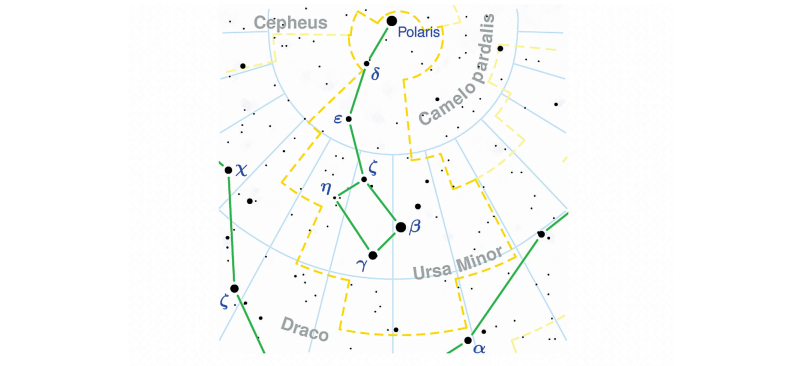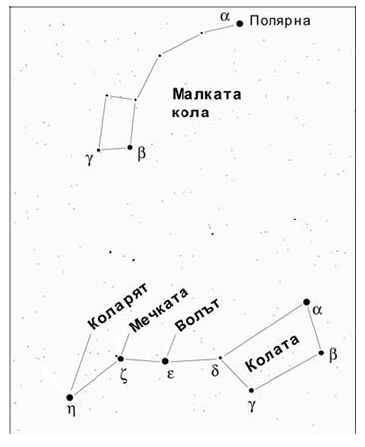INTRODUCTION
Astronomers are often called “star watchers”. The truth is that astronomers do not "watch" the stars, but they study them.
It is known that around 6000 stars can be seen on the sky with unaided eye such as at any given time an observer can see around 3000 stars above the horizon. These 3000 stars are just a tiny fraction of all of the stars in the Universe and naming and characterizing even this ‘small’ number of stars poses a challenge for astronomers.
Explanation, List of Constellation, Myths, Legends
Nowadays we have watches, calendars, compasses and many other tools. However, our ancestors thousands of years ago were limited only to using celestial objects in order to measure time and to determine locations and directions. To make this job easier, they divided stars into groups which we now call constellations. The brighter stars which formed easy to recognize shapes took the names of objects (Lyra, Librа, Triangulum, Sagitta, Corona Borealis, Crater, Scutum, etc); animals (Pisces, Aries, Taurus, Cancer, Leo, Scorpius, Ursa Major, Ursa Minor, Canis Major, Canis Minor, Cygnus, Aquila); mythical creatures such as Draco, Pegasus, Centaurus; or people (Hercules, Perseus, Orion, Cepheus, Cassiopeia, Andromeda).
Initially, each people gave different names to the constellations and the names were mainly derived from their legends and myths. Nowadays, there are artefacts indicating the different constellations used by the Mesopotamians, Sumerians, Babylonians, Persians, Egyptians, Chinese, Mayans, etc.

This way of grouping the stars into constellations helped astronomers, high priests as well as the ordinary people to find their way around the sky, to follow the sunrise and sunset as well as to trace the motion of the sun, the moon and the planets in between the stars. For millenia, this information was sufficient for daily life, for agriculture and cattle-breeding, for traveling near and far, for military activities, and for following rituals.
However, the ancient constellations did not include many faint stars. There were large areas on the sky which were not part of any constellations. Moreover, the first telescope observations demonstrated that there are many stars invisible to the unaided eye. Later, the telescope observations showed the existence of ‘fuzzy’ objects (such as nebulae and galaxies). This increased interest created the need to define new constellations in the areas with faint stars. There were also attempts to change the existing constellation names. During the Age of Discovery also the need to divide the southern sky into constellations arose as the Europeans travelled to the southern hemispheres.
Around that time, the astronomers from different countries began to communicate and to exchange ideas more frequently. Astronomy was developing with an increasing speed. This created the need to “put the sky in order”. Thus during a congress in 1922, the recently established International Astronomical Union agreed on a uniform celestial map. It divided the sky into 88 areas which correspond to the 88 modern constellations. Under these definitions, a constellation is not just a characteristic and recognizable conglomeration of stars. A constellation, instead, consists of all objects (stars, star clusters, nebulae, galaxies) which lie within the assigned area. The constellation borders lie along the celestial parallels and meridians and were defined by the International Astronomical Union in 1930.

Fig. 2 The constellation Ursa minor with its borders and the asterism “The Little Dipper”
The easily recognizable shapes formed by the brighter stars in a constellation are known as “Asterism”. Most often, asterisms are a fraction of a constellation. Well known examples are “The Big Dipper” (from the Ursa Major constellation), “The Little Dipper” (from Ursa Minor), “The Teapot & Spoon” (from Sagittarius). Other asterisms combine the brightest stars of different neighboring constellations, e.g. “Summer triangle” consisting of Vega (the brightest star of Lyra), Deneb (Cygnus) and Altair (Aquilla).

Fig. 3 The asterism “Winter triangle” formed by the three brightest stars Betelgeuse from Orion, Sirius (from Canis Major) and Procyon (from Canis Minor)
The majority of the modern constellations coincide with the shapes and the names of the constellations that the Ancient Greeks defined. They are therefore directly linked to the myths and legends of Ancient Greece. These are mainly the constellations from the northern celestial hemisphere which were observable from Ancient Greece and can be seen from most of Europe. 47 (48 ?) of these constellations preserved their Ancient Greek names. These are for example all of the zodiac constellations, as well as Auriga, Bootes, Cetus, Coma Berenices, Hydra.
https://en.wikipedia.org/wiki/Andromeda_(mythology)
In Greek mythology, Andromeda was the daughter of Cepheus and Cassiopeia, king and queen of the African kingdom of Aethiopia.[3]
Her mother Cassiopeia boasted that her daughter was more beautiful than the Nereids, the nymph-daughters of the sea god Nereus and often seen accompanying Poseidon. To punish the queen for her arrogance, Poseidon, brother to Zeus and god of the sea, sent a sea monster named Cetus to ravage the coast of Aethiopia including the kingdom of the vain queen. The desperate king consulted the Oracle of Apollo, who announced that no respite would be found until the king sacrificed his daughter, Andromeda, to the monster. Stripped naked, she was chained to a rock on the coast.[3]
Perseus was returning from having slain the Gorgon, Medusa. After he happened upon the chained Andromeda, he approached Cetus while invisible (for he was wearing Hades's helm), and killed the sea monster. He set Andromeda free, and married her in spite of her having been previously promised to her uncle Phineus. At the wedding a quarrel took place between the rivals, and Phineus was turned to stone by the sight of the Gorgon's head. Even some of the newer constellations (defined in 17th-19th century) were given names related to the Ancient Greek mythology. This is for example the case of Canes Venatici.
https://www.greekmyths-greekmythology.com/ursa-major-in-greek-mythology/

Fig. 4 Ursa Major Constellation
A special spot among constellation is taken by the zodiac constellations. These are the constellations which are crossed by the Sun during its apparent motions among the stars during a year. There are 13 zodiac constellations. However, astrologists have traditionally avoided the fatal number 13 and have therefore considered the zodiac signs to be just 12: Pisces, Aries, Taurus, Gemini, Cancer, Leo, Virgo, Libra, Scorpio, Ophiuchus, Sagittarius, Capricorn, Aquarius. The 13th zodiac constellation is Ophiuchus and it is located between Scorpio and Sagittarius. All of these constellations but Libra are named after living creatures, which gave them the name “zodiac”, from the Greek word “zoo” which means “animal”. The apparent path of the Moon and the planets on the sky also crosses these constellation, and therefore the zodiac constellations are frequently observed and very well known (independently of their astrological context).

Fig. 5 Zodiacal constellations
The constellations from the Southern hemisphere are also often named after animals (mythical or more exotic) – Tucana, Phoenix, Pavo, Apus, Volansis, etc. Another portion of the constellations reflect the epoch when they were first defined – the age of exploration, discovery and great voyages – Telescopium, Microscopium, Sextans, Octans, Antilia, etc.
The Bulgarians had their own constellations. Even though there are not many written records about the folklore and the songs, we know that in the regions of the Orion, Canis Major and Canis Minor, the Bulgarians identified the figures of the Ploughman, The Plough, The Oxen, The Goad and The Dog. This celestial scene matched perfectly its time of visibility from Bulgaria – when seen high in the sky around midnight, the people knew that it is time for ploughing and sowing the fields.

Fig. 6 Bulgarian versions of the constellations Orion, Canis Major and Canis Minor
One Bulgarian legend interprets the asterism of the Ursa Major constellation as a Wagoner, Bear, Ox and Cart. The legend is that while the wagoner was gathering wood in the forest, a bear had eaten one of the oxen. Then the wagoner (the star Alkaid) caught the bear (the star Mizar) and harnessed it next to the other ox (the star Alioth) to pull the cart (the stars Dubhe, Merak, Phecda, Megrez), and next to the cart was running the wagoner’s dog (the star Alcor.).

Fig. 7 Bulgarian names of the Bulgarian constellation the Cart ( Ursa Major)
Usually the constellation are given in an alphabetically ordered list according to their Latin names.
It is an important to point out that the objects comprising the constellations (stars, nebulae, etc.) are not physically bound and do not have similar distances to Earth. It is just their projection of the celestial sphere that forms the asterisms. The Andromeda galaxy appears in the constellation of Andrpomeda, but is a separate galaxy significantly further away from us than any of the brighter stars in the constellation.


